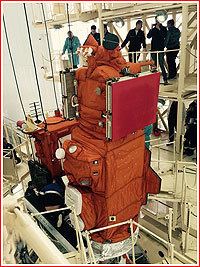COSPAR ID 2016-026A Mission duration Planned: 3 years Launch mass 620 kg (1,370 lb) Launch date 28 April 2016 | SATCAT no. 41464 Manufacturer VNIIEM Payload mass 170 kg (370 lb) Mission type Astronomy | |
 | ||
Similar Gamma, Spektr‑RG, Granat, Astron, AIST‑2D | ||
Mikhailo Lomonosov (or MVL-300) is an astronomical satellite of MSU named after Mikhail Lomonosov.
Contents
Mission
The objective of the missionis the observation of gamma-ray bursts, high-energy cosmic rays and transient phenomena in the Earth's upper atmosphere.
Launch
The mission launch was initially planned for 2011 when 300 years since the birthday of Mikhail Lomonosov was celebrated. After several postponements the mission was finally launched on 28 April 2016 from Vostochny Cosmodrome by the Soyuz 2.1a launch vehicle.
Scientific payload
The spacecraft is equipped with seven scientific instruments:
References
Mikhailo Lomonosov (satellite) Wikipedia(Text) CC BY-SA
